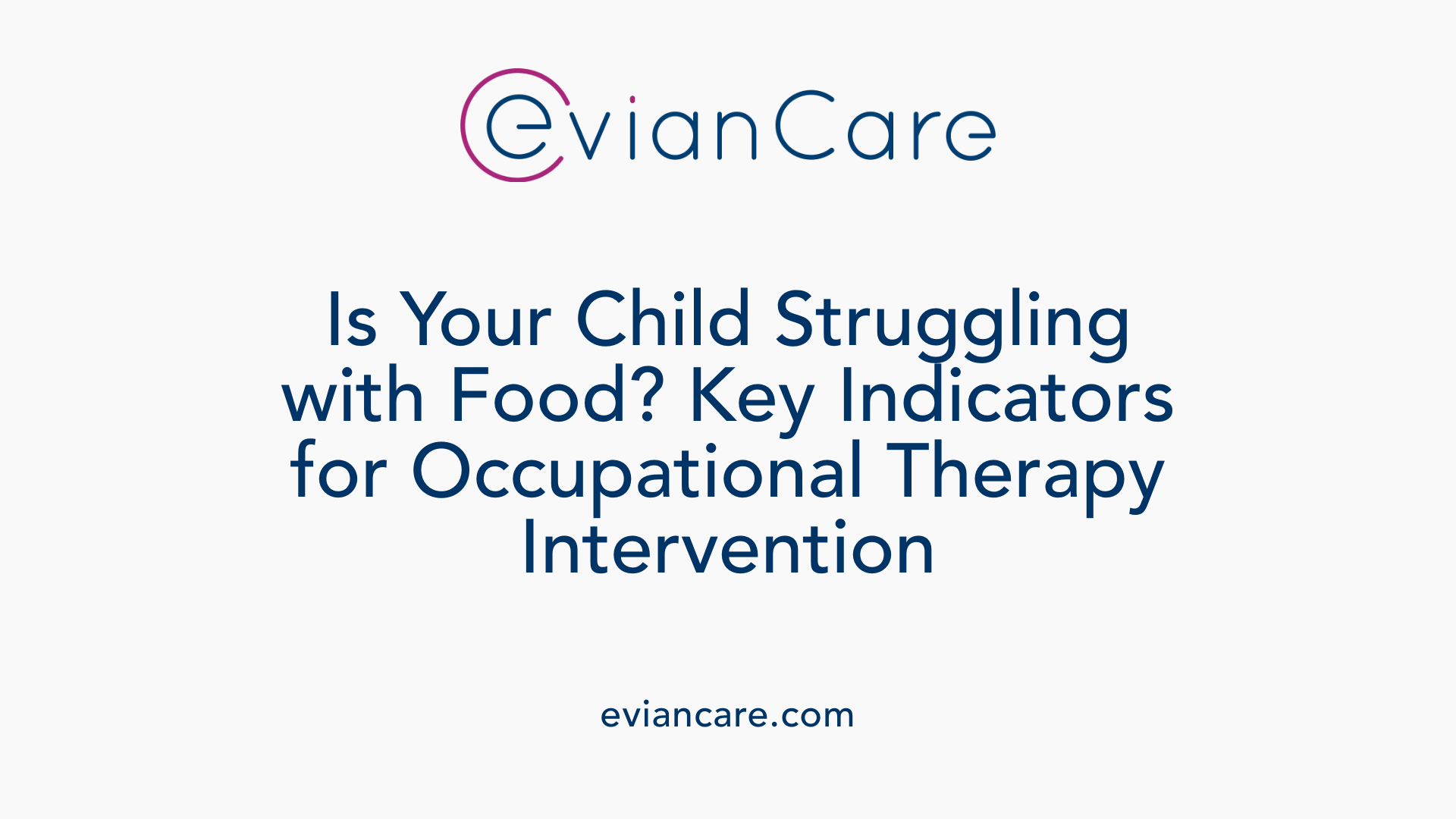
Understanding Feeding and Swallowing Difficulties in Children
Feeding and swallowing difficulties are common concerns affecting children of all ages, from infancy to school age. These challenges can stem from various medical, neurological, sensory, or developmental conditions and significantly impact a child's health, growth, and overall well-being. Recognizing the signs early and seeking appropriate intervention is crucial to promoting positive eating habits, safety, and independence. Pediatric occupational therapy plays a vital role in assessment, intervention, and family support—aiming to improve feeding outcomes and enhance quality of life for children and their caregivers.
Signs Indicating the Need for Occupational Therapy

What are the signs that indicate a child might need occupational therapy for feeding and swallowing difficulties?
Feeding challenges are common in children, but certain signs suggest that professional evaluation and intervention may be necessary. Persistent refusal to eat or drink, especially beyond the typical picky eating stage, is often an early indicator that a child might benefit from occupational therapy. This ongoing selectivity can signal underlying oral-motor, sensory, or behavioral issues affecting feeding.
A very limited diet restricted to a few foods or avoidance of entire food groups is another warning sign. When a child consistently refuses new foods or has a narrow range of accepted textures and flavors, it may reflect sensory sensitivities or oral motor delays that need addressing.
Difficulties with chewing, swallowing, or transitioning to textured foods are common reasons for concern. These issues can include gagging, choking, or coughing during meals, which not only impede nutrition but also increase the risk of aspiration.
Mealtime stress, prolonged duration, fussiness, or fussing during eating can also point to underlying problems. Children who experience discomfort or anxiety related to eating may develop behavioral patterns that hinder healthy growth.
Poor weight gain, growth delays, or recurrent respiratory infections such as pneumonia are more serious signs, often linked to aspiration or inadequate intake. These health issues underscore the importance of early assessment and intervention to prevent long-term consequences.
When any of these signs are present, consulting an occupational therapist specialized in feeding and swallowing is crucial. Early intervention can help improve oral motor control, sensory processing, and coordination, ensuring safer and more effective eating habits.
| Sign Indicator | Description | Potential Underlying Issues |
|---|---|---|
| Persistent refusal | Children refuse to eat or drink over time | Oral motor delays, sensory sensitivities |
| Limited diet | Restriction to few foods, avoidance of food groups | Sensory aversion, behavioral issues |
| Chewing or swallowing difficulties | Gagging, choking, coughing during meals | Motor coordination, neuromuscular problems |
| Mealtime stress | Prolonged, fussy, or stressful eating | Anxiety, sensory processing issues |
| Poor growth or recurrent infections | Weight delays, pneumonia | Aspiration, nutritional deficiency |
Addressing these signs early with professional help can promote better health outcomes, nutritional status, and a positive relationship with food. Pediatric occupational therapists are trained to assess and treat these feeding and swallowing difficulties with personalized strategies tailored to each child's needs.
How Occupational Therapy Supports Children with Feeding and Swallowing Difficulties

How does occupational therapy help children with feeding and swallowing problems?
Occupational therapy (OT) plays a vital role in assisting children who face challenges with feeding and swallowing. A primary step involves comprehensive assessments to understand each child's unique sensory, motor, and behavioral skills related to eating. OTs evaluate how a child processes food textures, reacts to sensory stimuli, their muscle strength during feeding, and behavioral responses during mealtime.
Based on these assessments, occupational therapists implement targeted interventions to create a supportive feeding environment. These strategies include modifications to the child's surroundings, such as adjusting lighting, noise levels, or seating, to minimize distractions. Proper positioning during feeding is emphasized to promote optimal swallowing mechanics and safety.
Adaptive equipment is often used to compensate for motor deficits or sensory sensitivities. This might involve specialized utensils, plates, or cups designed for easier handling and feeding. Sensory integration techniques, like tactile play or oral motor exercises, help children tolerate and accept different textures, tastes, and smells.
OTs develop individualized treatment plans addressing a range of influences on feeding, including physiological, psychosocial, and environmental factors. They work closely with families and collaborate with multidisciplinary teams, including speech-language pathologists and pediatricians, to ensure a cohesive approach.
Parental involvement is crucial; therapists educate caregivers on feeding techniques, behavioral strategies, and routines to reinforce skills learned during therapy. Behavioral support methods, such as positive reinforcement and response shaping, help establish positive mealtime behaviors.
The ultimate goal of occupational therapy in this context is to improve the child's oral-motor control, make eating safe and efficient, and increase acceptance of a broad diet. This promotes not only nutritional health but also social participation, fostering confidence and independence in feeding activities.
Regular follow-up and adjustments to therapy plans help ensure long-term development of healthy eating habits. Supporting children in building positive associations with food and mealtime is essential for their overall growth, health, and well-being.
In summary, occupational therapy supports children with feeding and swallowing difficulties through holistic, tailored interventions that address both physical and behavioral aspects, ensuring they can participate actively and safely in feeding routines and routines that promote lifelong healthy eating habits.
Medical Conditions and Causes of Feeding and Swallowing Difficulties in Children

What conditions or causes are associated with feeding and swallowing difficulties in children?
Feeding and swallowing problems in children often stem from a variety of medical and developmental conditions. These issues can impact a child's ability to eat safely, gain weight effectively, and develop healthy eating habits.
One common cause involves developmental delays, which can include delays in motor coordination or oral musculature, affecting the child's ability to chew and swallow properly. Neurological disorders such as cerebral palsy, neuromuscular diseases, and brain injuries are significant contributors. These conditions disrupt normal nerve signaling and muscle control, leading to difficulties in coordinating swallowing movements.
Structural anomalies also play a crucial role. Children born with cleft lip or palate, craniofacial abnormalities, or other anatomical irregularities like enlarged tongue or tonsils may experience obstructed oral or pharyngeal pathways. Such structural issues can impair the natural swallowing process and often require surgical intervention.
Medical treatments like surgery, radiation therapy, or chemotherapy, especially near the head and neck region, often cause or exacerbate feeding problems. These treatments may lead to tissue scarring, reduced saliva production, or nerve damage that hampers normal oral function.
Various conditions affecting the gastrointestinal tract further contribute to feeding challenges. Gastroesophageal reflux disease (GERD) causes painful acid reflux, making children reluctant to eat. Eosinophilic esophagitis, an allergic inflammatory condition of the esophagus, can cause pain and narrowing, complicating swallowing. Tumors or growths in the mouth, throat, or esophagus can physically block food passage or cause discomfort.
Prematurity and birth-related malformations such as esophageal atresia (where the esophagus does not develop properly) increase the risk of feeding and swallowing issues. These children often require specialized feeding strategies and medical interventions.
Sensory processing problems also influence feeding health. Children with heightened sensitivities to textures, tastes, or smells may resist eating certain foods, leading to nutritional deficiencies. Mouth or vocal cord irritation due to infections or trauma can cause pain during swallowing, resulting in feeding aversion.
In summary, feeding and swallowing difficulties can arise from a complex interplay of medical, anatomical, neurological, and sensory factors. Addressing these issues typically involves a multidisciplinary approach, including medical treatment, therapy, and nutritional support, to ensure safe and adequate nutrition for affected children.
Assessment Methods in Pediatric Feeding and Swallowing Therapy

What are common assessment methods used by occupational therapists for feeding and swallowing difficulties in children?
Occupational therapists (OTs) employ a wide array of assessment techniques to understand the roots of feeding and swallowing problems in children. These methods are designed to be comprehensive, gathering detailed information from multiple perspectives to ensure a holistic understanding of each child's unique challenges.
A primary assessment tool includes clinical feeding evaluations, where therapists observe the child's eating behaviors, mouth movements, and coordination during feeding. This often involves a physical examination to check the structure and function of oral and pharyngeal areas, such as the tongue, lips, palate, and throat. Observational assessments provide real-time insights into how children manage different textures and volumes of food and liquids.
Caregiver interviews are integral, offering crucial context about mealtime routines, feeding history, and behaviors outside of clinical settings. These conversations help therapists identify patterns, triggers, and environmental factors influencing feeding.
Growth measurements, including weight, height, and head circumference, are tracked regularly to monitor nutritional status, which often correlates with feeding effectiveness and issues.
Assessment of physiological and behavioral factors involves analyzing how sensory processing, motor skills, and psychological elements impact feeding. Therapists evaluate sensory responses to textures, tastes, and smells, as well as behavioral cues that may hinder or facilitate eating.
To standardize and validate findings, OTs often use research-based assessment tools like the Feeding Matters Infant and Child Feeding Questionnaire. These questionnaires help quantify feeding behaviors and identify areas needing intervention.
In more complex cases, instrumental assessments such as videofluoroscopic swallow studies (VFSS) and fiberoptic endoscopic evaluation of swallowing (FEES) are utilized. VFSS involves X-ray imaging while the child swallows various food and liquid consistencies, providing dynamic views of the entire swallow process. FEES uses a flexible endoscope inserted through the nose to observe the airway and swallowing in real-time without radiation exposure. These tools offer detailed anatomical and physiological data vital for diagnosis and treatment planning.
Assessment strategies are carefully tailored to the child's age, developmental stage, cultural background, and environment. For infants, this may include evaluating reflexes and muscle tone related to feeding, whereas older children might undergo assessments that consider social and emotional factors.
By combining medical evaluations, sensory and motor assessments, behavioral observations, and caregiver insights, occupational therapists develop comprehensive profiles of children's feeding difficulties. This detailed understanding enables the creation of personalized intervention plans aimed at improving safety, efficiency, and enjoyment of eating.
Evaluation and Assessment Process in Pediatric Occupational Therapy

What is the process of evaluation and assessment in pediatric occupational therapy for feeding and swallowing?
The evaluation and assessment process in pediatric occupational therapy is comprehensive, involving multiple steps to understand each child's unique needs. Therapists start by reviewing medical, developmental, and feeding histories in detail. This helps identify underlying medical conditions, developmental delays, or sensory issues contributing to feeding difficulties.
Next, they conduct caregiver interviews to gather insights into the child's feeding routines, behaviors, preferences, and challenges experienced at home and other settings. A physical examination of the child is also performed, focusing on oral motor structures, muscle strength, and coordination.
Careful observation during feeding sessions is essential. Therapists watch how the child handles different textures and consistencies, noting signs of difficulty, gagging, choking, or fatigue. These observations help assess behavioral responses and sensory sensitivities related to food and the eating environment.
Validated assessment tools play a vital role. Instruments such as the Feeding Matters Infant and Child Feeding Questionnaire, the Pediatric Evaluation of Disability Inventory (PEDI), and the Feeding Flock assessments provide standardized measures of the child's feeding skills, sensory processing, and oral motor abilities. Using these tools allows therapists to quantify difficulties and track changes over time.
Throughout the evaluation, therapists consider various factors influencing feeding, including physiological issues like reflux or prematurity, behavioral aspects such as refusal or tantrums, and sensory sensitivities to textures, tastes, smells, or environmental stimuli.
Behavioral analysis is also an integral part of assessment. Understanding the antecedents, functions of adverse behaviors, and environmental triggers helps develop effective behavioral interventions.
Ongoing monitoring and reassessment are crucial. Regular reviews using established tools gauge progress, inform modifications to intervention plans, and ensure goals remain aligned with the child's evolving needs.
This multidisciplinary and detailed process ultimately provides a comprehensive understanding of the child's feeding status, guiding personalized, targeted therapy to improve feeding skills, safety, and nutritional intake.
Goals, Outcomes, and Techniques in Occupational Therapy for Feeding and Swallowing

What are the typical goals and expected outcomes of occupational therapy for children with feeding and swallowing difficulties?
Occupational therapy (OT) for children facing feeding and swallowing challenges focuses on several important objectives. The primary goal is to enhance oral motor and sensory processing skills, which are crucial for safe and efficient eating. This involves strengthening muscles used in chewing, sucking, and swallowing, as well as addressing sensory sensitivities related to food textures, tastes, and smells.
Another key aim is to increase the variety and acceptance of foods. Many children with feeding difficulties show food selectivity or sensory aversions, and OT interventions help expand their dietary repertoire in a gradual, positive manner. Ensuring safe swallowing is vital to prevent aspiration and choking risks; thus, therapy also targets improving the child's ability to swallow different textures safely.
Reducing problematic mealtime behaviors, such as food refusal, temper tantrums, or refusal to try new foods, is another essential goal. By addressing these behaviors, OT supports smoother mealtimes and encourages positive associations with eating.
Participants typically experience several beneficial outcomes from therapy. These include greater food variety, increased intake, and reduced stress during meals. Improvements in oral motor control often lead to better chewing and swallowing efficiency, which contribute to healthier weight gain and overall nutrition.
Furthermore, therapy aims to empower caregivers with strategies to support their child's feeding development confidently. This increases their satisfaction and reduces mealtime frustration.
Goals are tailored to each child's individual needs, with progress monitored through specific, measurable objectives. Over time, many children achieve noticeable improvements in their feeding skills, independence, and quality of life.
Ultimately, OT strives to help children develop healthier eating habits that promote growth, development, and participation in family and social routines, making mealtimes more enjoyable for everyone involved.
How do occupational therapists implement these goals?
Implementation involves a variety of evidence-based techniques. Oral-motor exercises such as blowing bubbles, chewing vegetables, and using straws help strengthen oral muscles.
Sensory integration techniques are employed to desensitize children to different textures and tastes, often using playful food play and messy activities.
Behavioral strategies—like positive reinforcement, response shaping, and graduated exposure—are used to encourage acceptance of new foods and reduce mealtime anxiety.
Adjustments in positioning and environmental setup are made to promote optimal feeding posture and comfort, reducing physical barriers to eating.
Environmental modifications include providing adaptive utensils or specialized equipment that support independence and proper handling.
Therapists also educate and coach parents and caregivers, teaching them how to implement strategies consistently at home. This parental involvement is essential for reinforcing skills learned during therapy sessions.
Through ongoing assessment and goal adjustment, therapists ensure the intervention remains responsive to the child's evolving needs. Progress is documented through observable measures such as increased food variety, improved oral motor strength, and reduction in adverse behaviors.
In sum, the combination of targeted exercises, sensory and behavioral interventions, environmental adjustments, and active caregiver participation forms the foundation of effective occupational therapy for feeding and swallowing difficulties.
| Goals | Expected Outcomes | Techniques Used |
|---|---|---|
| Improve oral motor control | Increased variety of accepted foods | Oral-motor exercises (e.g., blowing, chewing) |
| Enhance sensory processing | Greater food acceptance and reduced sensitivities | Sensory integration activities (food play) |
| Increase safe swallowing | Decreased choking and aspiration risk | Positioning, swallowing maneuvers |
| Reduce problematic mealtime behaviors | Less mealtime stress and frustration | Behavioral strategies (reinforcement, shaping) |
| Promote caregiver confidence | More consistent feeding routines | Parent education and coaching |
This comprehensive approach allows children to develop healthy, safe, and enjoyable eating practices, ultimately supporting their overall health, growth, and social participation.
Empowering Families and Ensuring Safe, Enjoyable Mealtimes
Occupational therapy is a comprehensive, family-centered approach essential for addressing the complex feeding and swallowing challenges faced by children. Through thorough assessments, individualized interventions, and multidisciplinary collaboration, therapists work to improve oral-motor skills, sensory processing, behavioral responses, and environmental adaptations. The ultimate goal is to promote safe swallowing, increase food acceptance, and foster positive feeding experiences that support children's nutritional health and developmental progress. Caregivers are actively involved throughout the therapeutic process, receiving education and strategies to support their children at home. When early intervention is provided, children can develop lifelong healthy eating habits, reducing the risk of long-term nutritional and behavioral issues, and enhancing their overall quality of life.
References
- Occupational Therapy for Children with Feeding Difficulties
- Treating Feeding and Eating Problems in Children with ...
- [PDF] The Practice of Occupational Therapy in Feeding, Eating, and ...
- Pediatric Feeding and Swallowing - ASHA
- Pediatric Occupational Therapy for Picky Eaters & Problem Feeders
- Occupational Therapy Interventions to Support Feeding and ...
- Practice of Occupational Therapy in Feeding, Eating and Swallowing
- Occupational Therapy for Children with Feeding Difficulties
- Feeding and Swallowing Program | Children's Hospital Colorado
- Feeding and Swallowing Disorders in Children - ASHA












